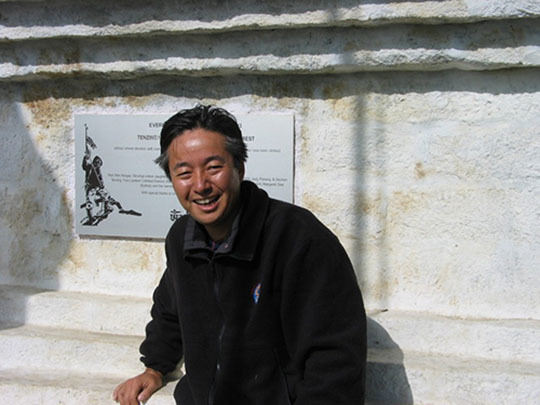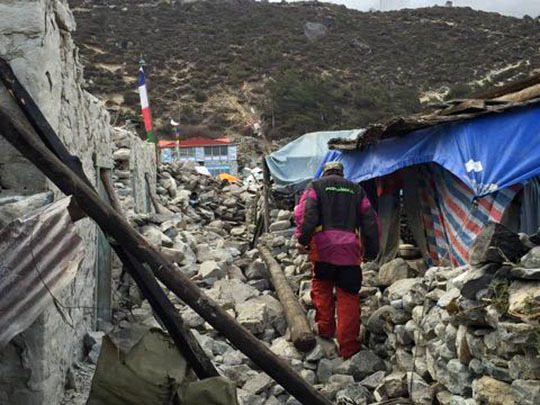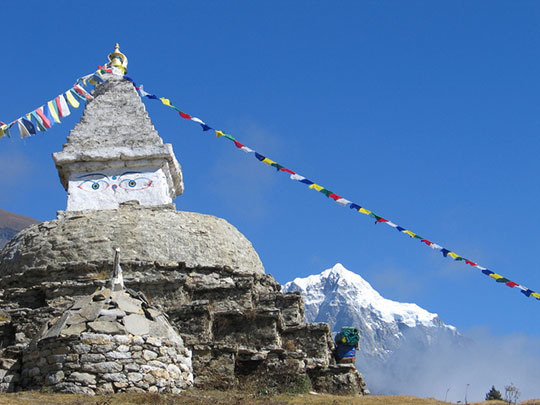
Norbu Tenzing Norgay is the son of one of the most recognizable figures in Himalayan mountaineering history, Tenzing Norgay Sherpa, who made the first ascent of Mt. Everest with Sir Edmund Hillary in 1953. A Nepali expat based in California, Norbu is vice president of the American Himalayan Foundation (AHF), which works with Himalayan communities on a wide range of initiatives, including schools, health care and cultural preservation. Following the recent earthquakes, the AHF has worked to provide immediate shelter and relief to the worst hit areas.
Norbu has written previously about the “business of Everest,” speaking out against exploitation of Sherpas and the mountain environment. On April 18, 2014–one week before the first of two major earthquakes struck Nepal and one year after the death of sixteen Sherpas in an avalanche forced a reevaluation of the risks that porters face daily–he wrote presciently on the the AHF blog: “The 2015 Everest season is well underway now: a parade of over 30 expeditions, each with their own motives and aspirations, are settling into Everest Base Camp….The results of the referendum on risk have come, and those with the power to decide have voted for business as usual.”
We reached out to Norbu Tenzing Norgay on May 22, to discuss some of the wider implications of the recent events, and responsibilities of climbers in the Himalaya.
Alpinist: What is the situation right now in Nepal?
NT: I was in Nepal, actually, two days after the earthquake. It was very surreal, being amidst the ruins of those collapsed buildings. I was absolutely stunned at the catastrophe that had taken place. Water is desperately needed. There is no food, [and no] sanitation supplies in some areas. We are still trying to get to many areas, especially to the people who live in high parts of Nepal. In the Everest area for example, we have areas that have had no aid [no food, shelter or medical relief].

Alpinist: What support have you received from the international community?
NT: We have been pleased and quite impressed with the outpouring of support. But we still have a ways to go. The big aid agencies, I believe, have some half a billion [dollars] that has been raised through various governments. A lot more is needed to make sure Nepal gets back on its feet.
Alpinist: Jan Morris recently wrote in The New Statesman: “no one needs to climb Mt. Everest–let’s turn it into a memorial.” Is this something you agree with?
NT: Jan is obviously a long-time family friend and a wonderful writer [Morris broke the news of Sir Edmund Hillary and Tenzing Norgay Sherpa’s first ascent of Everest in 1953–Ed.] I think she set a very high goal. Everest is a mountain that is sacred for Sherpas and Tibetans alike. It would be wonderful if the mountain shut down–personally, you know, it’s a wonderful idea. But I don’t think it’s really practical.
Cutting down the numbers and really putting some better systems in place I think would be very helpful, especially when it comes to the risk and inequity issues surrounding the “business of Everest.” That way the mountain has some room to breathe, I guess. Because right now it is essentially a cash cow, and the benefits really don’t translate equitably to those who really struggle, especially the Sherpas who make twenty to thirty trips up and down the [Khumbu] Icefall when the Western climber just goes once or twice.
When Sherpas first went on Everest, it was strictly a seasonal job. During the mountain season people go and climb, and the other times they would be farmers. But now it has become a full-blown business, and I think it’s too late to stop the barrage. Sherpas are much more educated and worldly and they want a bigger piece of the pie. It’s a complicated business. I have to be supportive of American companies in that they provide fairly decent salaries for the Sherpas. But I think reducing the risk for these Sherpas is really, really important, and finding some sort of better compensation.
It would be nice if nobody climbs Everest–just give it a break, you know. Give Everest a break.

Alpinist: This is two seasons in a row where disasters have forced people to take a break and reevaluate Everest. Have you seen anything that might indicate that attitudes are changing?
NT: Actually it has been three horrible seasons. The first one was when the fight broke out on Everest [We reported extensively on this incident in a news feature on July 11, 2013–Ed]. That was the beginning, and I think that bad things come in threes. I’ve always believed that, as a Buddhist–Sherpas are Buddhist and we are very superstitious.
But some small changes have started to take place. Insurance has gone up a little bit, from 10,000 to 15,000 dollars compensation for loss of life. People are more conscientious about the choices they make.
Alpinist: What would you like Alpinist readers to take away from the recent events?
NT: I think people who read the Alpinist are very sophisticated readers of climbing. If you are going to go back to Nepal in the wake of this earthquake, it is important to go and live out your dreams and climb big mountains–but just think about the choices you make. What I tell people is that, if one decides to climb Everest–or any mountain–always look in the eyes of the child whose father you are going to take and say that the father is going to be well taken care of. Because often that Sherpa on the Icefall is the sole breadwinner in the family.
[For thoughtful commentary on Nepal’s recovery and a list of recommended charitable organizations, see Pema Sherpa’s report: “Building Nepal from Near and Afar” on alpinist.com. To donate the AHF, visit himalayan-foundation.org.–Ed.]